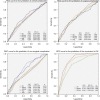The Zhongshan score: a novel and simple anatomic classification system to predict perioperative outcomes of nephron-sparing surgery
- PMID: 25654399
- PMCID: PMC4602723
- DOI: 10.1097/MD.0000000000000506
The Zhongshan score: a novel and simple anatomic classification system to predict perioperative outcomes of nephron-sparing surgery
Erratum in
- Medicine (Baltimore). 2015 Apr;94(14):DOI: 10.1097/01.md.0000464828.75442.31
Abstract
In the zero ischemia era of nephron-sparing surgery (NSS), a new anatomic classification system (ACS) is needed to adjust to these new surgical techniques. We devised a novel and simple ACS, and compared it with the RENAL and PADUA scores to predict the risk of NSS outcomes. We retrospectively evaluated 789 patients who underwent NSS with available imaging between January 2007 and July 2014. Demographic and clinical data were assessed. The Zhongshan (ZS) score consisted of three parameters. RENAL, PADUA, and ZS scores are divided into three groups, that is, high, moderate, and low scores. For operative time (OT), significant differences were seen between any two groups of ZS score and PADUA score (all P < 0.05). For ZS score, patients with moderate and high scores had longer warm ischemia time (WIT) and greater increase in SCr compared with low score (all P < 0.05). What is more, the differences between moderate and high scores classified by ZS score were borderline but trending toward significance in WIT (P = 0.064) and increase in SCr (P = 0.052). Interestingly, RENAL showed no significant difference between moderate and high complexity in OT, WIT, estimated blood loss, and increase in SCr. Compared with patients with a low score of ZS, those with a high or moderate score had 8.1-fold or 3.3-fold higher risk of surgical complications, respectively (all P < 0.05). As for RENAL score, patients with a high or moderate score had 5.7-fold or 1.9-fold higher risk of surgical complications, respectively (all P < 0.05). Patients with a high or moderate score of PADUA had 2.3-fold or 2.8-fold higher risk of surgical complications, respectively (all P < 0.05). In the ROC curve analysis, ZS score had the greatest AUC for surgical complications (AUC = 0.632) and the conversion to radical nephrectomy (AUC = 0.845) (all P < 0.05). In conclusion, the ability of ZS score to predict the surgical complexity and surgical complications of NSS is better than RENAL and PADUA scores. ZS score could be used to reflect the surgical complexity and predict the risk of surgical complications in patients undergoing NSS.
Conflict of interest statement
The authors have no funding and conflicts of interest to disclose.
Figures



Similar articles
-
The RENAL nephrometry score and the PADUA classification for the prediction of perioperative outcomes in patients receiving nephron-sparing surgery: feasible tools to predict intraoperative conversion to nephrectomy.Urol Int. 2013;91(3):261-8. doi: 10.1159/000353086. Epub 2013 Aug 23. Urol Int. 2013. PMID: 23988749
-
Performance Prediction for Surgical Outcomes in Laparoscopic Partial Nephrectomy Using Nephrometry Scores: A Comparison of Zhongshan and Radius, Exophytic/Endophytic, Nearness, Anterior/Posterior, Location Systems.J Laparoendosc Adv Surg Tech A. 2024 Apr;34(4):323-328. doi: 10.1089/lap.2023.0502. Epub 2024 Feb 7. J Laparoendosc Adv Surg Tech A. 2024. PMID: 38330407
-
Predictive Value of Nephrometry Scores in Nephron-sparing Surgery: A Systematic Review and Meta-analysis.Eur Urol Focus. 2020 May 15;6(3):490-504. doi: 10.1016/j.euf.2019.11.004. Epub 2019 Nov 24. Eur Urol Focus. 2020. PMID: 31776071
-
R.E.N.A.L. Score Outperforms PADUA Score, C-Index and DAP Score for Outcome Prediction of Nephron Sparing Surgery in a Selected Cohort.J Urol. 2016 Sep;196(3):664-71. doi: 10.1016/j.juro.2016.03.176. Epub 2016 Apr 14. J Urol. 2016. PMID: 27091569
-
Preoperative and intraoperative observations may differ during laparoscopic nephron-sparing surgery.J Endourol. 2011 Aug;25(8):1315-21. doi: 10.1089/end.2011.0072. Epub 2011 Jul 11. J Endourol. 2011. PMID: 21815792
Cited by
-
The zero ischemia index (ZII): a novel criterion for predicting complexity and outcomes of off-clamp partial nephrectomy.World J Urol. 2017 Jul;35(7):1095-1102. doi: 10.1007/s00345-016-1975-3. Epub 2016 Nov 24. World J Urol. 2017. PMID: 27885452
-
A "3S+f" Nephrometry Score System to Predict the Clinical Outcomes of Laparoscopic Nephron-Sparing Surgery.Front Oncol. 2022 Jul 14;12:922082. doi: 10.3389/fonc.2022.922082. eCollection 2022. Front Oncol. 2022. PMID: 35912177 Free PMC article.
-
Surgical strategy of bilateral synchronous sporadic renal cell carcinoma-experience of a Chinese university hospital.World J Surg Oncol. 2017 Feb 28;15(1):53. doi: 10.1186/s12957-016-1071-6. World J Surg Oncol. 2017. PMID: 28245846 Free PMC article.
-
Renal anatomical classification systems cannot predict the occurrence of vascular complications after partial nephrectomy.World J Urol. 2024 Apr 2;42(1):208. doi: 10.1007/s00345-024-04891-9. World J Urol. 2024. PMID: 38565733
-
Three-dimensional nephrometry scoring system: a precise scoring system to evaluate complexity of renal tumors suitable for partial nephrectomy.PeerJ. 2020 Feb 27;8:e8637. doi: 10.7717/peerj.8637. eCollection 2020. PeerJ. 2020. PMID: 32149027 Free PMC article.
References
-
- Ljungberg B, Cowan NC, Hanbury DC, et al. EAU guidelines on renal cell carcinoma: the 2010 update. Eur Urol 2010; 58:398–406. - PubMed
-
- Kutikov A, Uzzo RG. The RENAL nephrometry score: a comprehensive standardized system for quantitating renal tumor size, location and depth. J Urol 2009; 182:844–853. - PubMed
-
- Ficarra V, Novara G, Secco S, et al. Preoperative aspects and dimensions used for an anatomical (PADUA) classification of renal tumours in patients who are candidates for nephron-sparing surgery. Eur Urol 2009; 56:786–793. - PubMed
-
- Simmons MN, Ching CB, Samplaski MK, et al. Kidney tumor location measurement using the C index method. J Urol 2010; 183:1708–1713. - PubMed
-
- Simmons MN, Hillyer SP, Lee BH, et al. Diameter-axial-polar nephrometry: integration and optimization of R.E.N.A.L. and centrality index scoring systems. J Urol 2012; 188:384–390. - PubMed
MeSH terms
Substances
LinkOut - more resources
Full Text Sources
Medical
Research Materials

